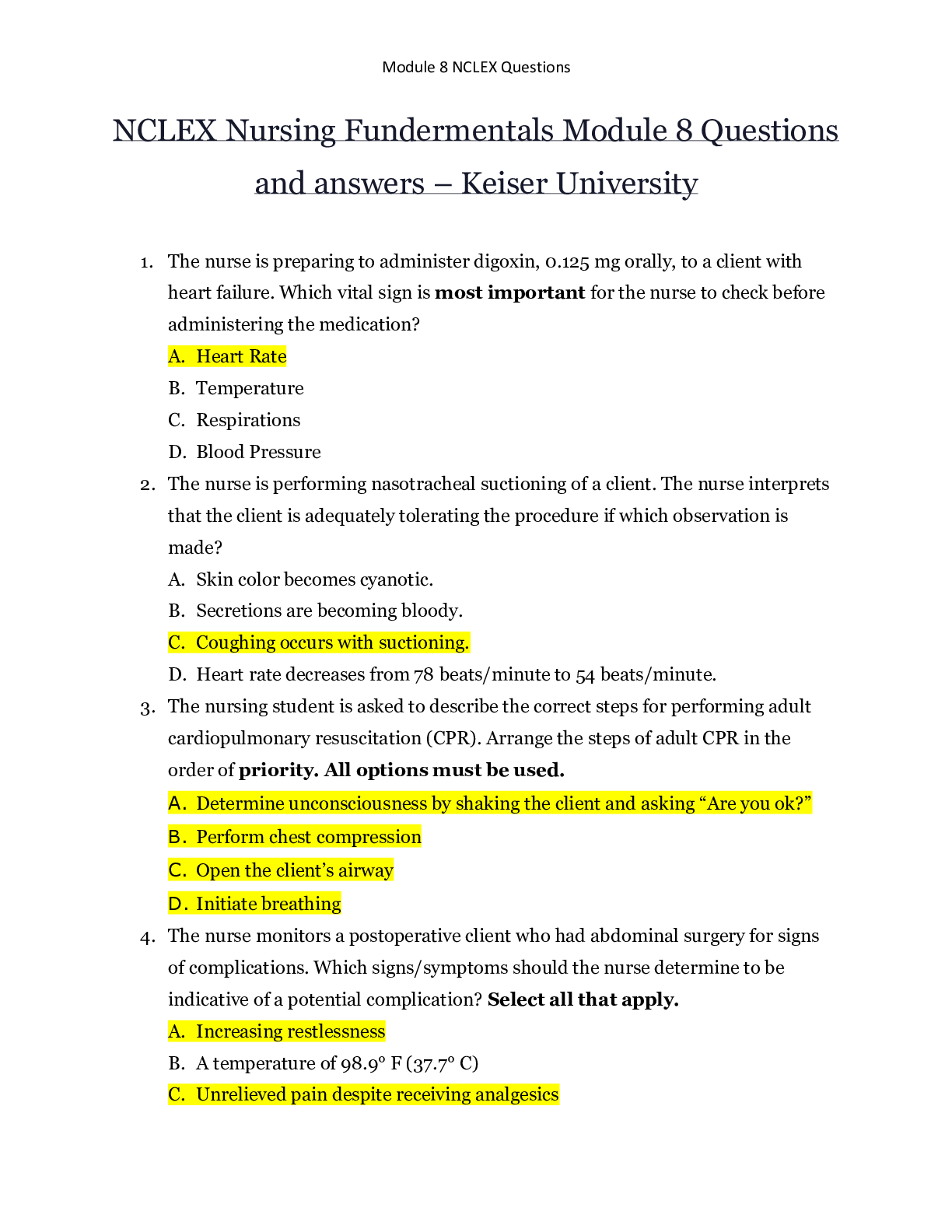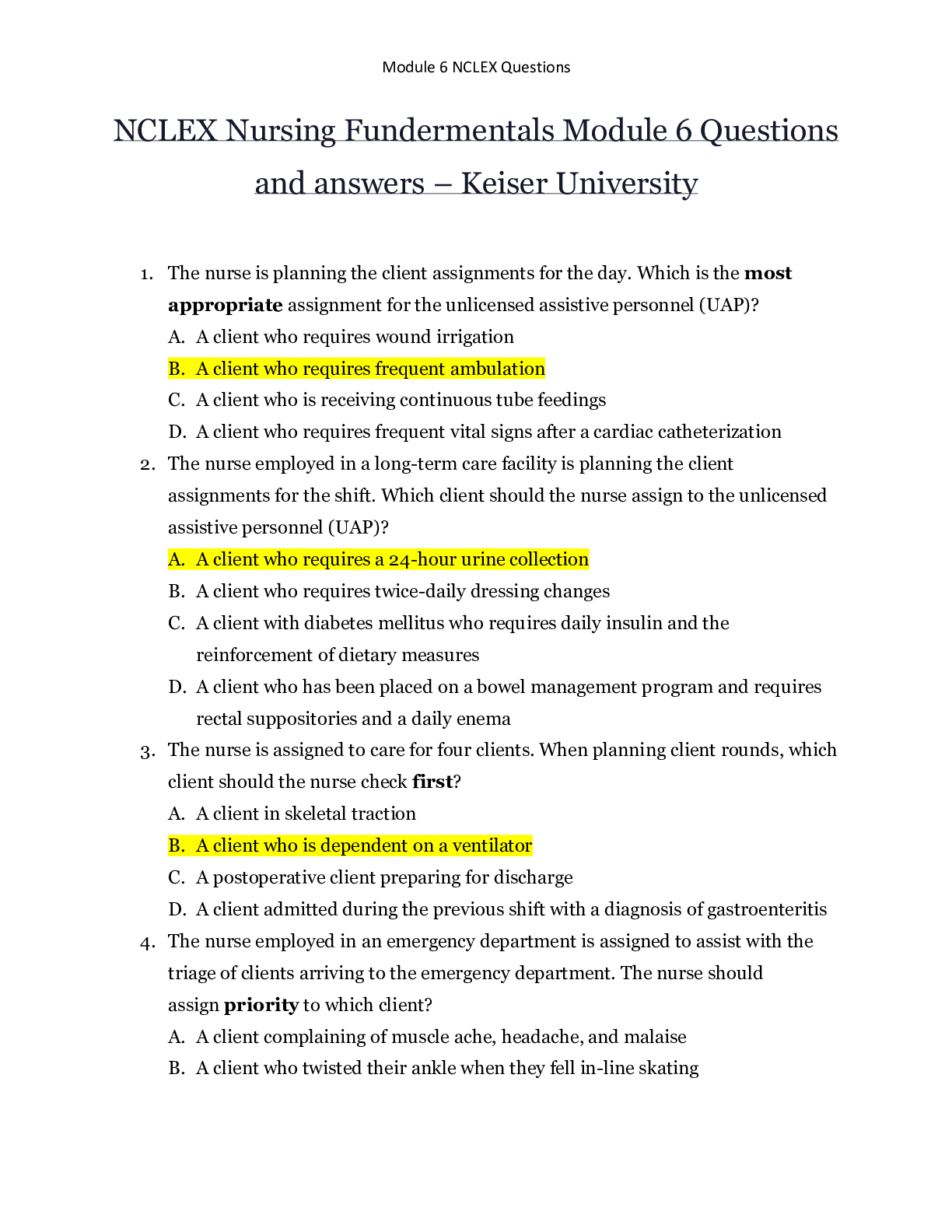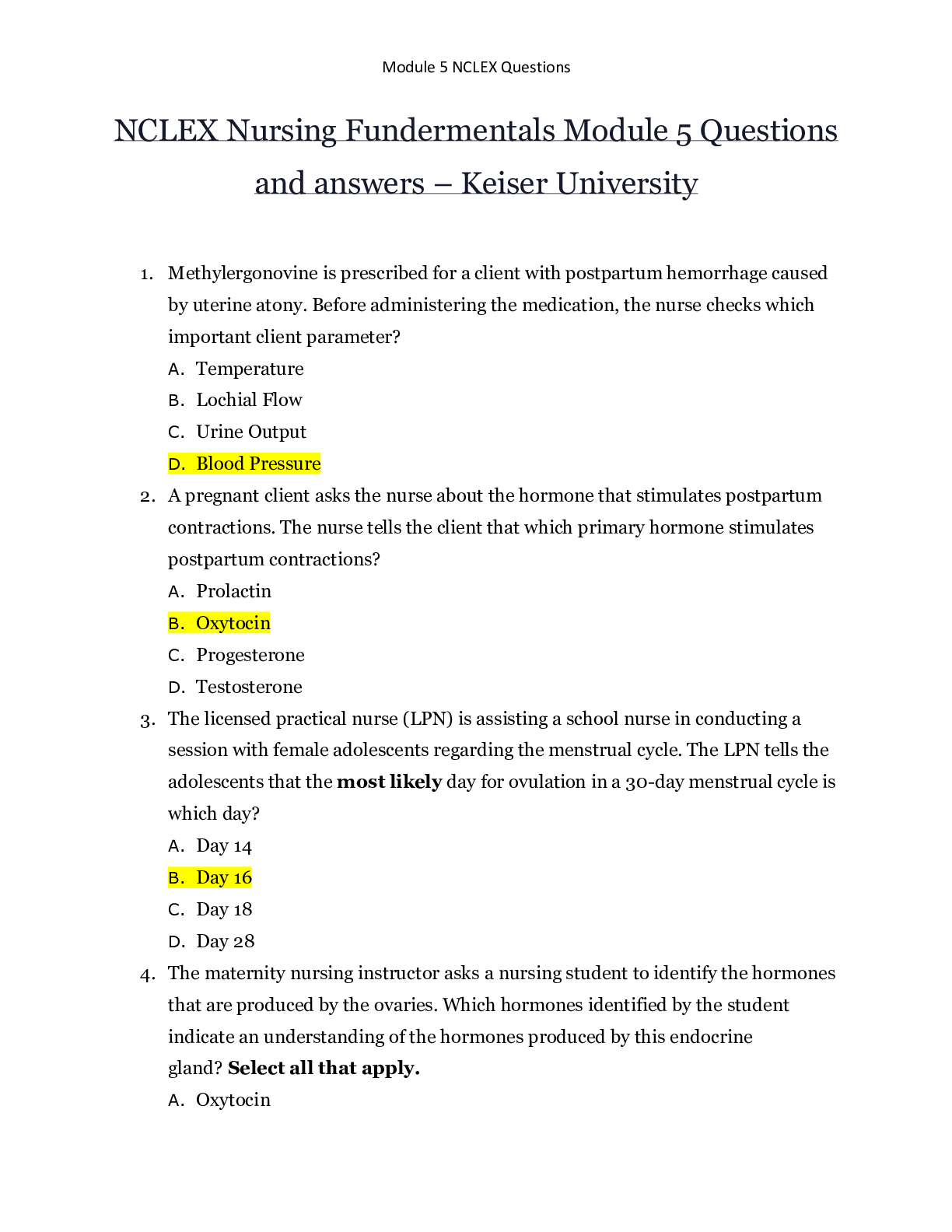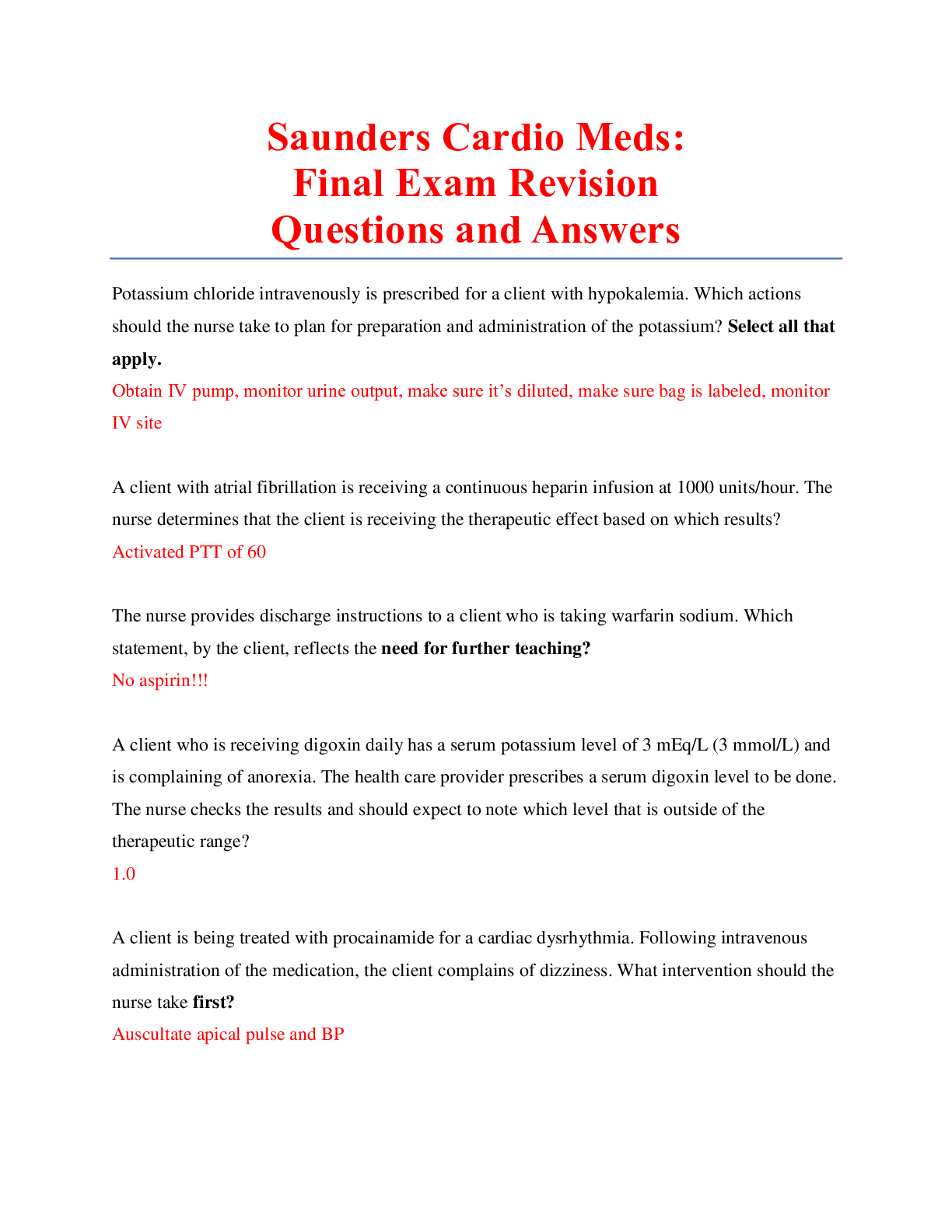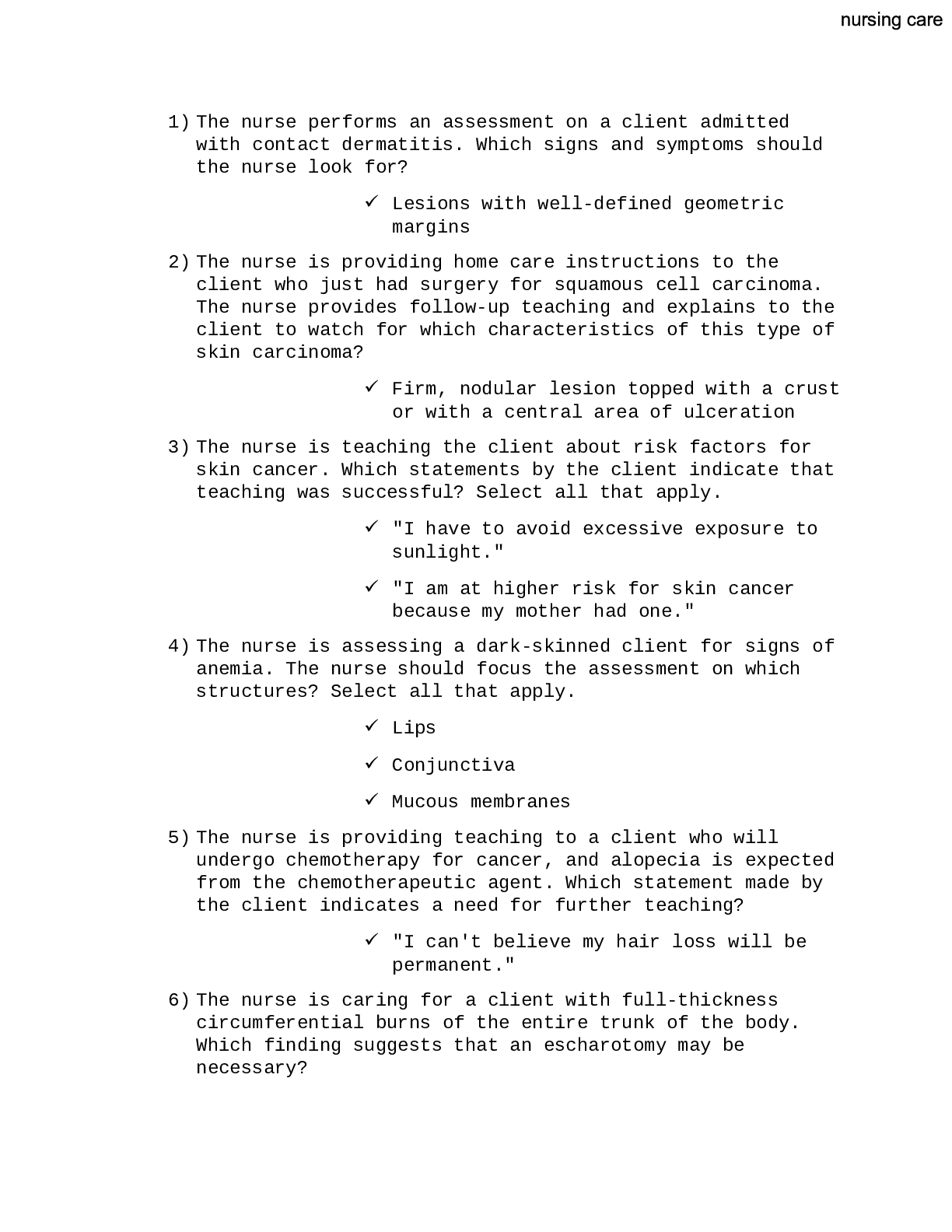*NURSING > NCLEX-RN > NCLEX Nursing Fundermentals Module 9 Questions and answers – Keiser University | NCLEX Nursing Fun (All)
NCLEX Nursing Fundermentals Module 9 Questions and answers – Keiser University | NCLEX Nursing Fundermentals Module 9 Questions and answers
Document Content and Description Below
NCLEX Nursing Fundermentals Module 9 Questions and answers – Keiser University 1. In the prenatal clinic, the nurse is gathering data from a new client for the health history information. Which a... ction is the best way for the nurse to elicit correct responses to questions that refer to sexually transmitted infections? A. Use specific closed-ended questions. B. Omit this area of questions because they are highly personal. C. Establish a therapeutic relationship between the nurse and pregnant client. D. Apologize for the embarrassment that these questions may cause the client. 2. A pregnant client is positive for the human immunodeficiency virus (HIV). The nurse educates the client and determines that there is a need for further teaching if the client makes which statement? A. "I can hold and diaper my newborn baby." B. "Breastfeeding my newborn will be the best option for my baby." C. "It may be as long as 2 years before I will know if my baby is HIV positive." D. "If I take the prescribed medications for HIV, it is possible that I may not transfer this disease to my newborn." 3. The nurse is gathering data from a 16-year-old pregnant client during her initial prenatal clinic visit. The client is beginning week 18 of her first pregnancy. Which client statement indicates a need for further investigation? A. "I don't like my figure anymore. My clothes are all too tight." B. "I don't like my breasts anymore. These silver lines are ugly." C. "I don't like my stomach anymore. That brown line is disgusting." D. "I don't like my face anymore. I always look like I have been crying." 4. The nurse has provided instructions to a client scheduled for a mammography regarding the procedure. Which statement by the client indicates an understanding of the procedure? A. "I cannot eat on the day of the test." B. "The test takes about 1 hour and is painless." C. "I will need to wear a sports bra for the procedure." D. "I should not wear deodorant on the day of the test." 5. A client returns to the nursing unit after an above-knee amputation of the right leg. In which position should the nurse place the client? A. Prone with the head on a pillow B. With the foot of the bed elevated C. Reverse Trendelenburg’s position D. With the residual limb flat on the bed 6. The nurse is assigned to assist in caring for a client who has had surgery and has pneumatic sequential compression devices (SCDs) in place. The client asks about these devices. The nurse instructs the client that SCDs are used for which purpose? A. Promoting venous return to the heart B. Preventing edema in the lower extremities C. Improving oxygenation to the lower extremities D. Decreasing the size of any thrombus that formed during surgery 7. The nurse is reviewing the laboratory results of a client scheduled for surgery. Which laboratory result should indicate to the nurse that the surgery might be postponed? A. Sodium, 140 mEq/L B. Hemoglobin, 8.4 g/dL C. Platelets, 200,000 mm3 D. Serum creatinine, 0.9 mg/dL 8. A client is seen in the urgent care center for complaints of chest pain 2 days ago. Since that time, the client has not been feeling well and fatigues easily. The nurse reviews the results of the laboratory tests. An elevation of which laboratory test indicates a myocardial infarction occurred at the time of chest pain 2 days ago? A. Myoglobin B. Troponin I C. Total Creatine Kinase (CK) D. B-Type Natriuretic Peptides (BNP) 9. A client is suspected of having a myocardial infarction. The nurse should expect elevations in which laboratory values to support the diagnosis? Select all that apply. A. Troponin I B. Thyroid stimulating hormone (TSH) C. Creatinine phosphokinase MB (CPK-BB) D. Creatinine phosphokinase MB (CPK-MB) E. Creatinine phosphokinase MB (CPK-MM) 10. A client who takes theophylline for chronic obstructive pulmonary disease (COPD) is seen in the urgent care center for respiratory distress. Just before initiating treatment for the respiratory distress, a sample for a theophylline level is drawn. The nurse notes the therapeutic range for the serum theophylline level is 10 to 20 mcg/mL and determines that the client may not be taking the medication as prescribed if which result is obtained? A. 6 mcg/mL B. 11 mcg/mL C. 15 mcg/mL D. 25 mcg/mL 11. The nurse is reviewing the complete blood count (CBC) laboratory results of a female adult client suspected of having iron deficiency anemia. The nurse reviews the results and determines that which results are consistent with this diagnosis? Select all that apply. A. Hemoglobin (Hgb) 8.8 g/Dl B. Hematocrit (Hct) 30% C. Platelet count 300,000 mm3 D. White blood count (WBC) 7500 mm3 E. Decreased mean corpuscular volume (MCV) 66 fL 12. The nurse is reinforcing instructions regarding cardiopulmonary resuscitation (CPR) to a group of nursing students. The nurse tells the group that when performing chest compressions on adults, the sternum should be depressed to at least which depth? A. 1 inch B. 2 inches C. One third to one half the depth of the chest D. Deep enough to make a hand impression 13. The nurse suspects that the client has a pulmonary embolism when the client exhibits which signs and symptoms? A. Dyspnea, tachypnea, and tachycardia B. Dry cough, shortness of breath, and back pain C. Edema, skin tenderness, and increased skin temperature D. Hematemesis, chest pain, and a feeling of impending doom 14. The nurse is assisting in administering beractant to a premature infant who has respiratory distress syndrome. The nurse understands that the medication should be administered by which route? A. Intradermal B. Intratracheal C. Subcutaneous D. Intramuscular 15. The nurse is checking the capillary refill of a child with a cast applied to the left arm. The nurse compresses the nail bed of a finger, and it returns to its original color in 2 seconds. Which action should be taken by the nurse? A. Document the findings B. Notify the RN C. Prepare the child for bivalving the cast D. Elevate the extremity and recheck the capillary refill immediately. 16. A child suspected of having sickle cell disease (SCD) is seen in a clinic, and laboratory studies are performed. Which laboratory value is likely to be increased in sickle cell disease? A. Platelet count B. Hematocrit level C. Hemoglobin level D. Reticulocyte count 17. The pediatric nursing instructor asks a nursing student to describe the cause of the symptoms that occur in sickle cell disease. Which is the correct response by the nursing student? A. "Bone marrow depression occurs because of the development of sickled cells." B. "Sickled cells increase the blood flow through the body and cause a great deal of pain." C. "The sickled cells mix with the unsickled cells and cause the immune system to become depressed." D. "Sickled cells are unable to flow easily through the microvasculature, and their clumping obstructs blood flow." 18. The nursing student is presenting a clinical conference and discusses the causative factors related to beta-thalassemia. Which group is at greatest risk of developing this disorder? A. A child of Mexican descent B. A child Mediterranean descent C. A child whose intake of iron is extremely poor D. A child breast-fed by a mother with chronic anemia 19. The nurse is assisting in providing surgical instructions to a preoperative client who will have abdominal surgery. Which instructions would be appropriate to include in the preoperative plan of care? Select all that apply. A. Wound Care B. Personal Hygiene C. Activity Restrictions D. Frequent assessment of vital signs E. Coughing and deep breathing exercises F. Pain monitoring and medications to relieve pain 20. A nursing instructor asks a student nurse assigned to care for an infant with a diagnosis of tricuspid atresia to describe the infant's disorder. Which statement by the student indicates the need to further research this disorder? A. "The infant has a single vessel that overrides both ventricles of the heart." B. "This disorder causes frequent episodes of hypercyanotic spells." C. "The disorder means there is no communication from the right atrium to the right ventricle of the heart." D. "The disorder means there is no communication from the systemic and pulmonary circulations of the heart." 21. Prostaglandin E1 is prescribed for a child with transposition of the great arteries. The parent of the child asks the nurse why the child needs the medication. The nurse correctly responds that the purpose of this medication is which explanation? A. Maintains an adequate hormone level B. Prevents hypercyanotic (blue or tet) spells C. Maintains the position of the great arteries D. Provides adequate oxygen saturation and maintains cardiac output 22. The nurse is caring for a child with a suspected diagnosis of rheumatic fever (RF). The nurse reviews the laboratory results. Which laboratory study should assist in confirming the diagnosis of RF? A. Immunoglobulin B. Red Blood Cell Count C. Antistreptolysin O Titer D. White Blood Cell Count 23. A child is brought to the emergency department for treatment of an acute asthma attack. The nurse prepares to administer which medication first? A. A B2-Agonist B. Oral Corticosteroids C. A Leukotriene Modifier D. A Nonsteroidal Anti-Inflammatory 24. A nursing student is asked to discuss sudden infant death syndrome (SIDS) at the clinical conference being held at the end of the clinical day. The student plans to include which information in the discussion during the conference? A. SIDS usually occurs during sleep and is more common in girls. B. SIDS usually occurs during sleep and is more common in premature infants. C. SIDS usually occurs during sleep and is more common in high-birth-weight infants. D. SIDS usually occurs during sleep and most frequently occurs between 8 and 10 months of age. 25. The nurse is checking for the presence of cyanosis in a dark-skinned client. Which body area should provide the best information? A. Sacrum B. Earlobes C. Back of the Hands D. Palms of the Hands 26. The nurse is assigned to assist in caring for a client with frostbite of the toes. Which should the nurse anticipate to be prescribed for this condition? A. Rapid and continual rewarming of the toes when flushing occurs B. Rapid and continual rewarming of the toes in cold water for 45 minutes C. Rapid and continual rewarming of the toes in hot water for 15 to 20 minutes D. Rapid and continual rewarming of the toes in a warm-water bath until flushing of the skin occurs 27. The nurse is assisting in caring for a client who has sustained a nasal fracture. The nurse monitors for which priority finding specifically related to this injury? A. Leakage of clear fluid from the nose B. Inability to breathe through one nare C. Hematoma formation around the eyes D. Edema noted around the nose and eyes 28. The nurse is caring for a client who is taking metoprolol. The nurse measures the client's blood pressure (BP) and apical pulse immediately before administration. The client's BP is 122/78 mm Hg and the apical pulse is 58 beats per minute. Based on this data, which is the appropriate action? A. Withhold the medication B. Notify the registered nurse immediately C. Administer the medication as prescribed D. Administer half of the prescribed medication 29. The nurse is caring for a client who has been prescribed cold pack applications to the right lower extremity. The nurse plans to collect which data specifically associated with this therapy before the initiation of therapy? Select all that apply. A. Pedal pulses B. Capillary refill C. Color of the extremity D. Temperature of the skin E. Condition of the toenails F. Presence of numbness 30. The nurse is suctioning an unconscious client who has a tracheostomy. The nurse should avoid which action during this procedure? A. Keeping a supply a suction catheters at the bedside B. Suctioning for longer than 30 seconds C. Auscultating breath sounds to determine the need for something D. Hyperoxygenating the client before, during, and after suctioning 31. The nurse is caring for a client admitted with fat embolism syndrome (FES). Which are some of the early manifestations of this syndrome? Select all that apply. A. Fever B. Dyspnea C. Petechiae D. Hypoxemia E. Tachypnea F. Decreased level of consciousness 32. The nurse is monitoring a child following a tonsillectomy. Which finding would indicate that the child is bleeding? A. Restlessness B. A decreased pulse rate C. Complaints of discomfort D. An elevation in blood pressure (BP) 33. The nurse is caring for a 2-year-old child diagnosed with croup. The nurse collects data on the child, knowing that which are characteristics of this illness? Select all that apply. A. The cough is harsh and metallic. B. Inspiratory stridor may be present. C. Symptoms usually worsen at night and are better during the day. D. Symptoms usually worsen during the day and are relieved during sleep. E. It is usually preceded by several days of upper respiratory infection symptoms. 34. A child with croup is being discharged from the hospital. The nurse reinforces home care instructions to the mother and advises the mother to bring the child to the emergency department if the child develops which symptom? A. Stridor B. Irritability C. Tiredness D. Poor Fluid Intake 35. A child with croup is placed in a cool-mist tent. The mother becomes concerned because the child is frightened, consistently crying, and tries to climb out of the tent. Which is the appropriate nursing action? A. Tell the mother that the child must stay in the tent. B. Place a toy in the tent to make the child feel more comfortable. C. Let the mother hold the child and direct a cool mist over the child's face. D. Consult with the registered nurse about obtaining a prescription for a mild sedative. 36. A child with croup is placed in a cool-mist tent. The mother asks if the child may have her security blanket inside the tent. Which is the most appropriate response by the nurse? A. "The child may have the security blanket inside the tent." B. "Objects from home are not allowed to be brought to the hospital." C. "The blanket is not allowed because it will promote the growth of bacteria." D. "The blanket is not allowed, but the child may have a toy from the hospital playroom." 37. A mother arrives at the emergency department with her child and a diagnosis of epiglottitis is documented. Which of the primary health care provider's prescription should the nurse question? A. Obtain a throat culture B. Obtain axillary temperatures C. Administer humidified oxygen D. Administer antipyretics for fever 38. The emergency department nurse is gathering initial data on a child suspected of epiglottitis. Which is the nurse's highest priority? A. Check for a patent airway B. Prepare the child for an x-ray C. Prepare the child for tracheotomy D. Assist the primary health care provider with intubation 39. The nurse caring for an infant with bronchiolitis is monitoring for signs of dehydration. The nurse monitors which method as reliable for determining fluid loss? A. Intake B. Output C. Skin turgor D. Body weight 40. Ribavirin is prescribed for the hospitalized child with respiratory syncytial virus (RSV). The nurse prepares to administer this medication via which route? A. Orally B. Via Face Mask C. Intravenously D. Intramuscularly 41. A 10-year-old child with asthma is treated for acute exacerbation. Which finding would indicate that the condition is worsening? A. Warm, dry skin B. Increased wheezing C. Decreased wheezing D. A pulse rate of 90 beats per minute 42. A mother arrives at the clinic with her child. The mother tells the nurse that the child has had a fever and a cough for the past 2 days, and this morning the child began to wheeze. Viral pneumonia is diagnosed. Which component of the treatment plan should the nurse anticipate? A. Oral antibiotics B. Supportive treatment C. Hospitalization and antibiotics D. Intravenous (IV) fluid administration 43. A mother of a child being treated for right lower lobe pneumonia at home calls the clinic nurse. The mother tells the nurse that the child has discomfort on the right side and that the acetaminophen is not very effective. Which is the best suggestion by the nurse? A. Increase the dose of the acetaminophen. B. Encourage the child to lie on the left side. C. Encourage the child to lie on the right side. D. Increase the frequency of the acetaminophen. 44. The nurse is reviewing the health record of an infant with a diagnosis of gastroesophageal reflux. Which signs/symptoms of this disorder should the nurse expect to note documented in the record? A. Excessive oral secretions B. Bowel sounds heard over the chest C. Hiccupping and spitting up after a meal D. Coughing, wheezing, and short periods of apnea 45. The nurse teaches a child with cystic fibrosis how to perform the "huff" maneuver. Which instructions should the nurse tell the child? A. Take a deep breath and then exhale rapidly, whispering the word huff. B. Take a shallow breath and then exhale rapidly, whispering the word huff. C. Take a deep breath, hold it for 15 seconds and then exhale slowly, whispering the word huff. D. Take a shallow breath, hold it for 10 seconds and then exhale rapidly, whispering the word huff. 46. A mother of a child with cystic fibrosis asks the nurse when the postural drainage should be performed. The mother states that the child eats meals at 8:00 am, 12 noon, and at 6:00 pm. What times should the nurse tell the mother to perform postural drainage? A. 8:00 am, 2:00 pm, and 6:00 pm B. 9:00 am, 1:00 pm, and 6:00 pm C. 8:00 am, 12:00 noon, and 6:00 pm D. 10:00 am, 2:00 pm, and 8:00 pm 47. The nurse is assigned to care for a client who has experienced uterine rupture. The nurse plans care knowing that which is the priority concern in caring for the client A. Fear B. Grieving C. Acute Pain D. Impaired Gas Exchange 48. The nurse is monitoring a client who is receiving oxytocin to augment labor. The nurse determines that the dosage should be decreased and notifies the registered nurse if which is noted? A. Fetal Tachycardia B. Increased urinary output C. Contractions occurring every 3 minutes D. Soft uterine tone palpated between contractions 49. A client is undergoing electronic fetal monitoring (EFM), and the nurse informs the client about the procedure. Which statement indicates to the nurse that the client correctly understands this procedure? A. "I'm getting tired of lying flat on my back." B. "I shut the machine off when I talk on the telephone." C. "What an efficient way to record my baby's heart rate." D. "How many volts of electricity are going through my body?" 50. The nurse is assisting in caring for a pregnant client who is on continuous fetal monitoring, and the nurse is asked to obtain a fetal monitor strip. Which is the most important information for the nurse to document on the strip? A. Age of client B. Maternal vital signs C. Last menstrual period D. A temporary interruption in recording 51. The nurse checks the vital signs of an infant with a respiratory infection and notes that the respiratory rate is 50 breaths per minute. Which action is appropriate? A. Administer oxygen B. Document the findings C. Notify the registered nurse D. Recheck the respiratory rate in 15 minutes 52. The nurse is caring for a client with sickle cell disease who is in labor. The nurse ensures that the client receives appropriate intravenous (IV) fluid intake and oxygen consumption to primarily accomplish which goal? A. Stimulate the labor process B. Prevent dehydration and hypoxemia C. Avoid the necessity of a cesarean delivery D. Eliminate the need for analgesic administration 53. The pregnant client with mitral valve prolapse is receiving anticoagulant therapy during pregnancy. The nurse collects data on the client and expects the client will indicate that which medication is prescribed? A. Oral intake of 15 mg of warfarin daily B. Subcutaneous administration of terbutaline C. Intravenous infusion of heparin sodium 5000 units daily D. Subcutaneous administration of heparin sodium 5000 units daily 54. The nurse is monitoring a preterm newborn for respiratory distress syndrome (RDS). Which findings in the newborn should alert the nurse to the possibility of this syndrome? A. Acrocyanosis and grunting B. Tachypnea and retractions C. Hypotension and bradycardia D. Barrel chest and acrocyanosis 55. A client who has fallen from a roof and fractured his ribs has arterial blood gas (ABG) results of: pH 7.48, Paco2 32 mm Hg, Pao2 89 mm Hg, and HCO3- 22 mEq/L. How should the nurse interpret the client's blood gas results? A. Normal results B. Respiratory Acidosis C. Metabolic Acidosis D. Respiratory Alkalosis 56. The nurse is caring for a client being treated for fat embolus after multiple fractures. Which data indicate to the nurse a favorable resolution of the fat embolus? A. Minimal Dyspnea B. Clear Chest X-Ray C. Oxygen Saturation 85% D. Arterial Oxygen Level of 78 mm Hg 57. A client with chronic atrial fibrillation is being started on amiodarone as maintenance therapy for dysrhythmia suppression. The nurse reinforces instructions to the client about the medication. Which statement by the client indicates a need for further teaching? A. "I will need to have routine follow-up with my ophthalmologist." B. "I will need to use sunscreen and protective clothing when outside." C. "I will periodically have blood drawn to monitor my thyroid function." D. "I will stop taking the prescribed anticoagulant after starting this new medication." 58. The nurse is planning to reinforce instructions to a client with peripheral arterial disease about measures to limit disease progression. The nurse should include which items on a list of suggestions to be given to the client? Select all that apply. A. Wear elastic stockings. B. Be careful not to injure the legs or feet. C. Use a heating pad on the legs to aid vasodilation. D. Walk each day to increase circulation to the legs. E. Cut down on the amount of fats consumed in the diet. 59. The nurse should monitor for which laboratory result as indicating an adverse reaction in the client who is receiving chemotherapy? A. Hemoglobin 12.5 g/Dl B. Platelet count 20,000 mm3 C. Blood urea nitrogen (BUN) 20 mg/dL D. White blood cell count (WBC) 7000 mm3 60. The nurse is caring for a client with a tracheostomy tube who is receiving mechanical ventilation. The nurse is monitoring for complications related to the tracheostomy and suspects tracheoesophageal fistula when which occurs? A. Suctioning is required frequently. B. Aspiration of gastric contents occurs when suctioning. C. The client's skin and mucous membranes are light pink. D. Excessive secretions are suctioned from a tracheostomy. 61. The nurse is assigned to care for a client who had a Sengstaken-Blakemore tube inserted when more conservative treatment failed to alleviate the condition. The nurse should most likely suspect that the client has which diagnosis? A. Gastritis B. Bowel Obstruction C. Small Bowel Tumor D. Esophageal Varices 62. A client who sustained an inhalation injury arrives in the emergency department. On data collection, the nurse notes that the client is very confused and combative. The nurse determines that the client is experiencing which problem? A. Fear B. Pain C. Hypoxia D. Anxiety 63. A client is brought to the emergency department following a smoke inhalation injury. The initial nursing action is to prepare the client to receive which treatment? A. Pain medication B. Endotracheal Intubation C. Oxygen Via Nasal Cannula D. 100% Humidified Oxygen by Face Mask 64. An emergency department nurse is caring for a client who sustained a burn injury to the anterior arms and anterior chest area. The client sustained the burn from a home fire that occurred in the basement. Which data would indicate that the client sustained a respiratory injury as a result of the burn? A. Fear and anxiety B. Complaints of pain C. Clear breath sounds D. Use of accessory muscles for breathing 65. A client in labor has an underlying diagnosis of sickle cell anemia. During labor the client is at high risk for sickling crisis. The nurse should take which action to assist in preventing a crisis from occurring during labor? A. Reassure the client. B. Maintain strict asepsis C. Prevent bearing-down D. Administer oxygen as prescribed 66. A 45-year-old woman delivered her first baby by cesarean section 5 days ago. The postpartum recovery has been complicated by thrombophlebitis in her left leg. She cries frequently and requests to have her newborn infant stay in the nursery. The nurse recognizes that the mother may have intensified "postpartum blues" because of which situation? A. The client is unable to nurse the baby. B. The client is an older first-time mother. C. The client is required to stay on bed rest. D. The client is considering giving the baby up for adoption. 67. The nurse is caring for a postpartum client who is being treated for thrombophlebitis. The client is receiving an anticoagulant by intravenous infusion. The nurse monitors for adverse effects of the anticoagulant by checking the client for which signs/symptoms? Select all that apply. A. Dysuria B. Epistaxis C. Headache D. Hematuria E. Ecchymosis 68. The goal for the postpartum client with deep thrombophlebitis is to prevent the complication of pulmonary embolism. In planning care to assist in meeting this goal, the nurse should perform which action? A. Check heart rate every hour. B. Check respirations every hour. C. Check blood pressure every hour. D. Administer anticoagulants as prescribed. 69. The nurse is caring for a newborn with respiratory distress syndrome (RDS). Which data obtained by the nurse indicate potential complications associated with this disorder? A. No seizure activity; anterior fontanel soft and flat B. No visible bowel loops; abdomen soft with active bowel sounds C. No audible heart murmur; pulse rate between 135 and 145 beats per minute D. No audible breath sounds in left lung; heart sounds louder in right side of chest 70. The nurse notes hypotonia, irritability, and a poor sucking reflex in a full-term neonate admitted to the newborn nursery. The nurse determines that which additional sign would be consistent with fetal alcohol syndrome (FAS)? A. Length 19 inches B. Birth weight 6 pounds 14 ounces C. Microcephaly and increased respiratory effort D. Head circumference appropriate for gestational age All questions came from NCLEX Saunder’s Study Guide [Show More]
Last updated: 2 years ago
Preview 1 out of 17 pages
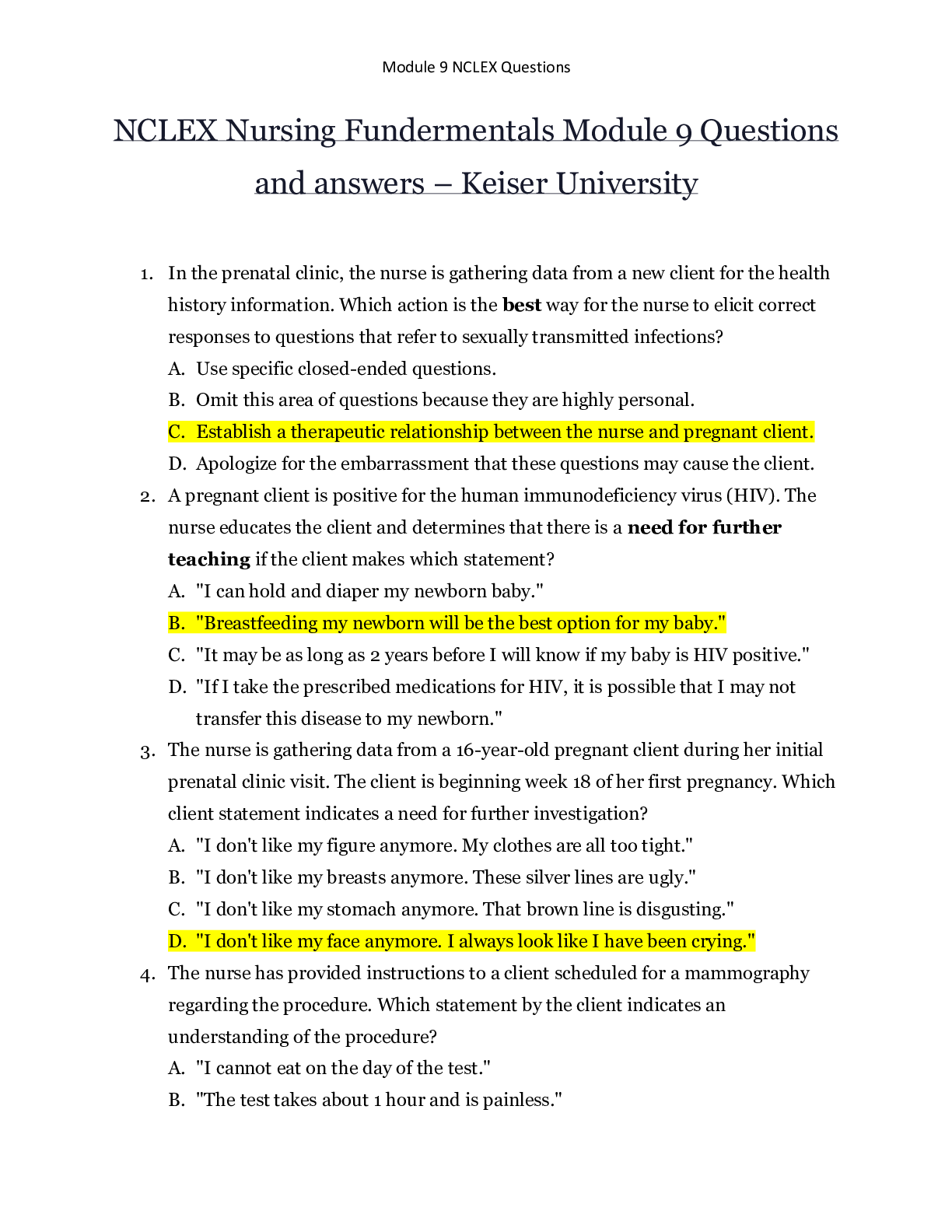
Buy this document to get the full access instantly
Instant Download Access after purchase
Buy NowInstant download
We Accept:

Reviews( 0 )
$12.50
Can't find what you want? Try our AI powered Search
Document information
Connected school, study & course
About the document
Uploaded On
Aug 14, 2020
Number of pages
17
Written in
Additional information
This document has been written for:
Uploaded
Aug 14, 2020
Downloads
0
Views
134

 - Florida International University.png)
 - Florida International University.png)
 - Florida International University.png)
 - Florida International University.png)
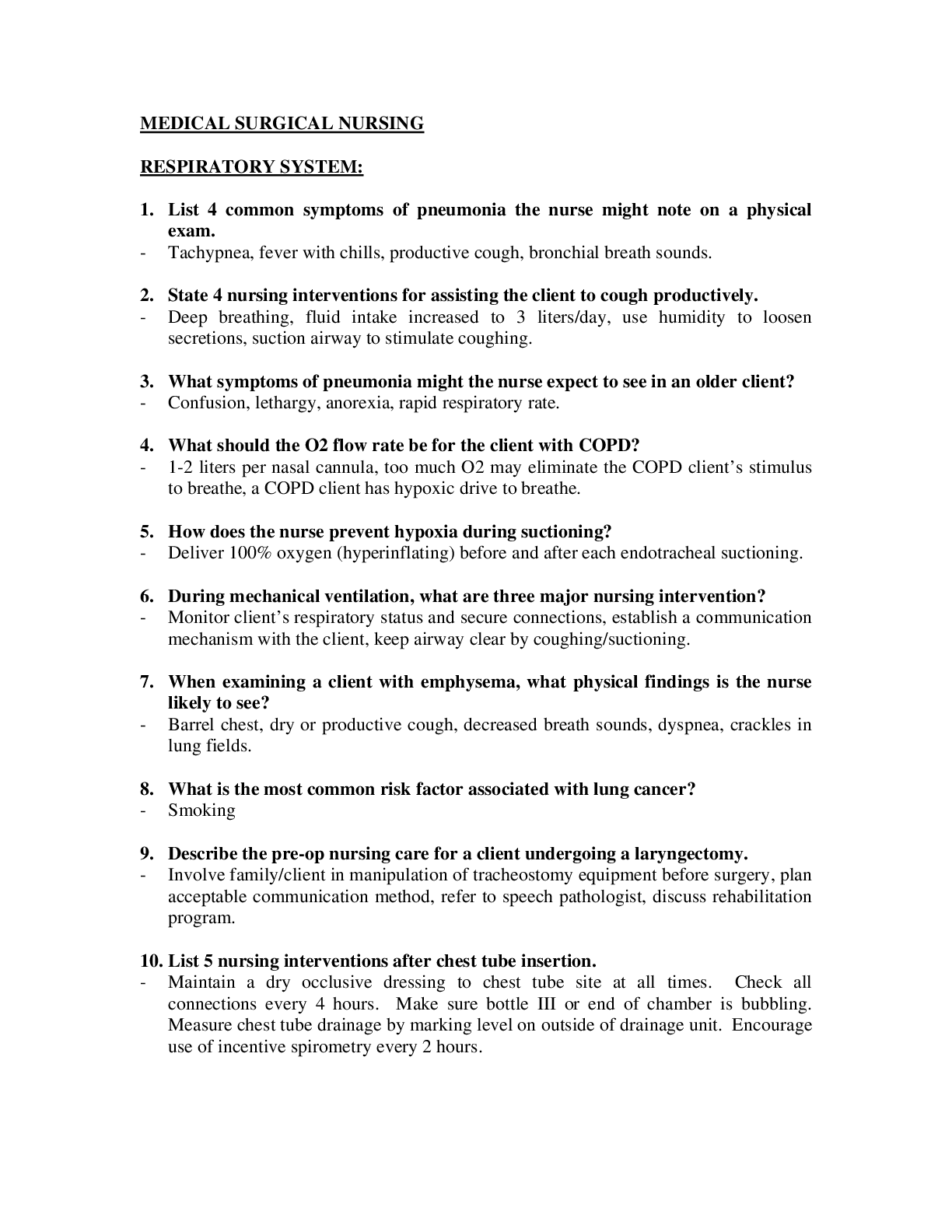

 Questions and answers – Keiser University.png)
